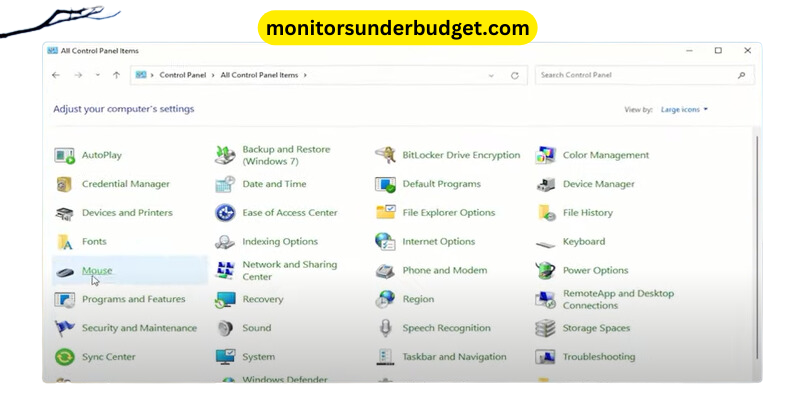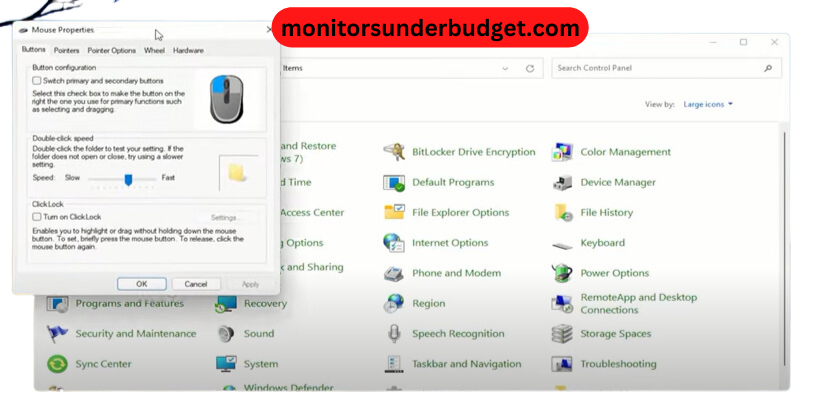If you have dual monitors and you want to know how to change the way mouse moves with dual monitors, you can do a few things. You can use the Mouse Properties dialog box in Windows to change how your mouse moves. In Mac OS X, you can use System Preferences to change how your mouse moves.
Step By Step: How To Change The Way Mouse Moves With Dual Monitors
In Windows, you can use the Mouse Properties dialog box to change how your mouse moves between monitors. To do this, follow these steps:

1. Click Start, and then click Control Panel.
2. In the Control Panel window, double-click Mouse.
3. In the Mouse Properties dialog box, click the Pointer Options tab.
4. Under Screen options, do one of the following:
– To have the mouse pointer wrap around to the other side of the screen when it reaches the edge, select the WrapPointer check box.
– To have the mouse pointer stop at the edge of the screen, clear the WrapPointer check box.
5. Click OK.
In Mac OS X, you can use System Preferences to change how your mouse moves between monitors. To do this, follow these steps:
1. Click the Apple menu, and then click System Preferences.
2. In the System Preferences window, click Mission Control.
3. In the Mission Control preferences, do one of the following:
– To have the mouse pointer wrap around to the other side of the screen when it reaches the edge, select the “Wrap around” check box.
– To have the mouse pointer stop at the edge of the screen, clear the “Wrap around” check box.
4. Close the System Preferences window.
What you need
Many people now use multiple monitors to enhance their productivity, but did you know that you can also change how your mouse moves between them? First, go to the control panel and navigate to the “Mouse” settings.
From there, find the option labeled “Dual Monitor” or “Multiple Display.” Select the option that adjusts the way your mouse moves between screens, such as following a straight line or jumping directly from one monitor to another.
Finally, apply the changes and enjoy a more streamlined experience with your dual monitors. Keep in mind that this setting may be different for macOS users. So be sure to check your computer’s specific instructions for changing this setting.
With these steps, you’ll have everything you need to make moving your cursor between screens a smoother process.
Set up your primary monitor
Setting up your primary monitor can make all the difference in improving your productivity and workflow. When configuring your monitors, start by placing your primary monitor directly in front of you, at eye level.
Next, adjust the display settings to match the resolution of your primary monitor. If using multiple monitors, consider enabling a function that allows you to drag and drop items seamlessly between screens.
Another helpful tip is to change how your mouse moves with dual monitors. By default, it may jump from one screen to another, but you can change this setting to move fluidly across both screens. Take time to configure and optimize your primary monitor for optimal efficiency and comfort.
Set up your secondary monitor
A secondary monitor can increase productivity and ease the strain on your eyes. To begin, locate the appropriate ports on both your computer and the monitor. Next, connect the cables and turn on both devices.
Your computer should detect the new monitor automatically, but if not, you may need to adjust settings through your control panel or display settings.
From there, you can choose how you want your mouse to move between screens – for example, you can set it to go from left to right or utilize a keyboard shortcut.
Finally, consider personalizing your monitors with background images or screensavers to make them feel like an integrated part of your workspace. By following these steps, you’ll be able to take advantage of the benefits a secondary monitor has to offer.
Change the mouse settings
The way your mouse moves can have a significant impact on productivity and efficiency. If you have multiple monitors, you may notice that the cursor jumps from one screen to the other in a disorienting fashion.
Thankfully, there are simple steps you can take to change this behavior. Go to the control panel on Windows computers and select “Mouse.” Under the “Pointer Options” tab, you’ll see an option for “Show location of pointer when I press the CTRL key.”

Checking this box will allow you to easily track where your cursor is on each screen by pressing the Control key. You can also choose how your mouse moves between screens by selecting either “Through One Monitor Only” or “Across Monitors.”
Experiment with these settings until you find a setup that suits your needs. Adjusting the mouse settings may seem like a small change, but it can significantly improve your overall workflow.
Could you test it out?
Are you having trouble navigating between two monitors with a single mouse? If you’re looking for an easy solution, why not try out the “mouse keys” feature on your computer? This handy option allows you to use the number pad on your keyboard to control the movement of your mouse.
To activate this feature, go to the control panel and search for “ease of access.” From there, find the option for “mouse keys,” and check the box to turn it on.
Now, instead of moving your physical mouse, you can use the number pad to move it around on the screen. Give it a try and see if it helps make navigating dual monitors a bit easier!
Troubleshooting
When it comes to troubleshooting, the first step is to identify the specific issue. In the case of a mouse moving differently on dual monitors, this can usually be resolved by adjusting the settings in your operating system.
On a Windows computer, go to Control Panel and select “Mouse.” Under “Buttons,” you can change the primary monitor and adjust how the cursor moves between screens. On a Mac, go to System Preferences and select “Displays” where you can find options for changing the arrangement of your screens.
If these steps do not solve the issue, there may be a problem with your graphics card or hardware setup that requires further troubleshooting or professional assistance. Ultimately, taking the time to correctly identify and address technical issues can save frustration and improve overall performance.
FAQs About How To Change The Way Mouse Moves With Dual Monitors
How do I set up a second monitor?
To set up a second monitor, you must connect the appropriate cables from your computer to the monitor. Once the monitor is plugged in and turned on, your computer should automatically detect it. If not, you may need to adjust settings through your control panel or display settings.
Can I use a second monitor with my laptop?
Yes, you can use a second monitor with your laptop. You will most likely need to connect an external monitor to your laptop through an HDMI or VGA port.
Once the monitor is plugged in and turned on, your computer should automatically detect it. If not, you may need to adjust settings through your control panel or display settings.
What are the benefits of using a dual monitor setup?
Using a dual monitor setup has several benefits, including increased productivity, improved efficiency, and enhanced multitasking capabilities. You can easily reference two screens while working on the other by having two screens side-by-side.
This can be helpful when you need to reference data or compare two documents. Additionally, having two monitors can make it easier to multitask by allowing multiple programs to open simultaneously.
What are the disadvantages of using a dual monitor setup?
A few potential disadvantages of using a dual monitor setup include the cost of an additional monitor and the need for extra space on your desk. Additionally, dual monitors can decrease productivity by causing distractions if misconfigured.
If you find yourself constantly looking at the other screen while working, it may be best to stick with a single monitor setup.
How do I change the mouse settings on my computer?
On a Windows computer, go to Control Panel and select “Mouse.” Under “Buttons,” you can change the primary monitor and adjust how the cursor moves between screens. On a Mac, go to System Preferences and select “Displays,” where you can find options for changing the arrangement of your screens.
If these steps do not solve the issue, there may be a problem with your graphics card or hardware setup that requires further troubleshooting or professional assistance.
How do I fix a mouse that is moving differently on dual monitors?
In most cases, this issue can be resolved by adjusting the settings in your operating system. On a Windows computer, go to Control Panel and select “Mouse.” Under “Buttons,” you can change the primary monitor and adjust how the cursor moves between screens.
On a Mac, go to System Preferences and select “Displays,” where you can find options for changing the arrangement of your screens.
If these steps do not solve the issue, there may be a problem with your graphics card or hardware setup that requires further troubleshooting or professional assistance. Ultimately, taking the time to correctly identify and address technical issues can save frustration and improve overall performance.
Conclusion
This post is for you if you have ever found yourself struggling to use your mouse across dual monitors. By following the simple steps outlined above.
You can change the way your mouse moves with dual monitors in no time. So why wait? Get started today and see how much easier it is to use your computer with two screens.
